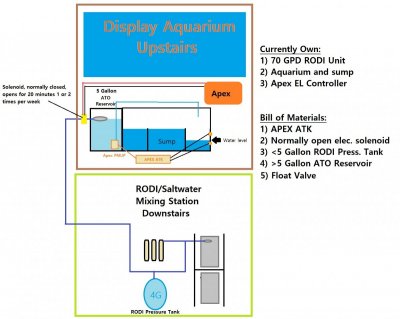- Joined
- Feb 23, 2020
- Messages
- 55
- Reaction score
- 29
Long time reefer here, and I FINALLY own a house that is suitable for the display aquarium I have always wanted. The current setup is a custom 165 gallon with a Trigger Systems Ruby Sump in the stand that has been running for about 9 months, and I am finally ready to start automating/upgrading. The first item I want to add is ATO. I have performed extensive research on Reef2Reef (what a great resource) and totally appreciate the benefit of having high/low tech redundancies in place. After studying some systems and plans, can someone take a look at the design I am proposing and either confirm it sounds prudent or provide any recommendations based on their own personal experience? Thanks in advance for everyone's time and energy!
Here is the plan:
Based on rough estimates, I will need approximately 4 gallons of RODI water/week to satisfy the evaporation needs of my aquarium. I intend to utilize an ATO reservoir of less than 5 gallons with the APEX ATK. I intend to also utilize a <5 gallon RODI pressurized holding tank in the basement next to the RODI unit. The RODI unit would fill the pressurized tank with approximately 4 gallons of RODI water. An electronic solenoid would be located between the pressurized tank and the RODI reservoir which would open for 20 minutes once or twice per week. This serves two purposes. 1st it will prevent the pressurized tank from filling to often eliminating TDS creep, and second, it introduces the first level of redundancy by preventing the RODI unit from over filling the reservoir. In addition, the sump COULD accommodate the entirety of the 4 gallons of RODI water from the holding tank in the event of a failure. This is another redundancy, and finally I will likely add a float valve in the reservoir as an added level of redundancy.
The APEX ATK would be used as recommended with the high/low water level and the PMUP being located inside the reservoir to fill the sump. Finally, I will probably add leak detection sensors around the failure points as an added form of redundancy, but I'm most curious about the ATO plan.
I have an option of wall mounting the ATO reservoir on the wall behind the aquarium and using a gravity fed method for ATO, but I was concerned about using float valves inside the sump with possible failures.
How does it look?!

Here is the plan:
Based on rough estimates, I will need approximately 4 gallons of RODI water/week to satisfy the evaporation needs of my aquarium. I intend to utilize an ATO reservoir of less than 5 gallons with the APEX ATK. I intend to also utilize a <5 gallon RODI pressurized holding tank in the basement next to the RODI unit. The RODI unit would fill the pressurized tank with approximately 4 gallons of RODI water. An electronic solenoid would be located between the pressurized tank and the RODI reservoir which would open for 20 minutes once or twice per week. This serves two purposes. 1st it will prevent the pressurized tank from filling to often eliminating TDS creep, and second, it introduces the first level of redundancy by preventing the RODI unit from over filling the reservoir. In addition, the sump COULD accommodate the entirety of the 4 gallons of RODI water from the holding tank in the event of a failure. This is another redundancy, and finally I will likely add a float valve in the reservoir as an added level of redundancy.
The APEX ATK would be used as recommended with the high/low water level and the PMUP being located inside the reservoir to fill the sump. Finally, I will probably add leak detection sensors around the failure points as an added form of redundancy, but I'm most curious about the ATO plan.
I have an option of wall mounting the ATO reservoir on the wall behind the aquarium and using a gravity fed method for ATO, but I was concerned about using float valves inside the sump with possible failures.
How does it look?!




















